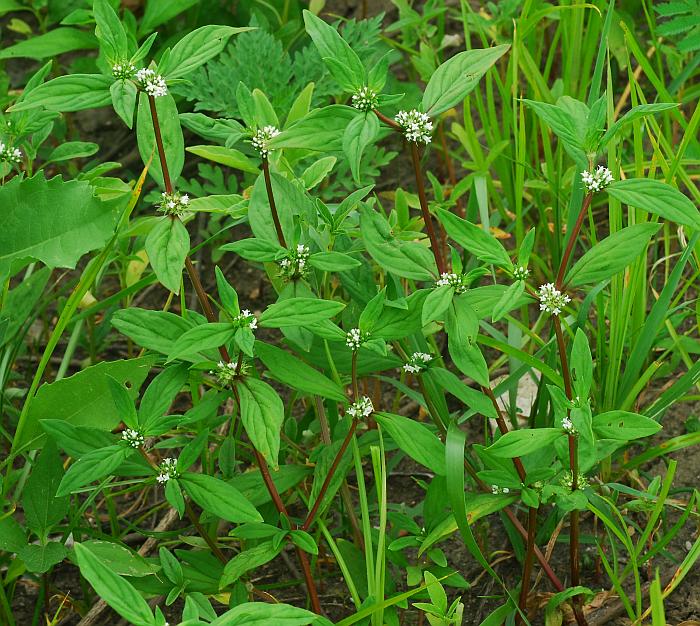Spermacoce glabra Michx.
Buttonweed

Native
CC = 5
CW = -3
MOC = 42
© SRTurner
Spermacoce glabra Michx.Buttonweed | |
 |
Native CC = 5 CW = -3 MOC = 42 |
© SRTurner |
|
Family - Rubiaceae Habit - Annual forb. Stem - Ascending to erect or sometimes trailing, to 60 cm, squarish in cross section, glabrous.
Leaves - Opposite, simple, sessile, entire, stipulate. Stipules interpetiolar, papery to scalelike, truncate to broadly rounded at the tips, fused to the leaf bases on either side, the sheath 1.5-3.5 mm long, membranous, bearing along its margin 5-7 bristles, these 1.5-6.0 mm long, usually somewhat unequal with the middle ones longer. Leaf blades 2-8 cm long, 3-24 mm wide, narrowly elliptic, angled at the base, angled to a sharply pointed tip, the margins flat, entire, sometimes with minute spinules angled toward the leaf tip, the surfaces glabrous, not glandular, the venation with the midvein and 2 or 3 pairs of secondary veins visible.
Inflorescences - Dense sessile axial clusters of 3-20 flowers at upper stem nodes.
Flowers - Calyces deeply 4-lobed, the lobes 1.5-2.0 mm long, narrowly triangular, glabrous. Corollas 2.5-4.0 mm long, funnelform, 4-lobed to about the midpoint, white, the outer surface glabrous, densely bearded in the throat with the pubescence often extending onto the upper surface of the lobes, these not overlapping in bud. Stamens 4, attached in the corolla throat, partially exserted. Stigmas 2, linear, not exserted. Ovary fully inferior, 2-locular, the ovules 1 per locule.
Fruits - Achenelike, indehiscent, 3-4 mm long, 2-3 mm wide, obconic and somewhat flattened laterally, the surface smooth, leathery to stiffly papery.
Flowering - June - October. Habitat - Streambanks, pond margins, sloughs, bottomland forests, bottomland prairies, ditches, wet roadsides. Origin - Native to the U.S. Other info. - This common denizen of moist riverbanks is similar in appearance to the bugleweeds (Lycopus spp). It is easily distinguished by its interpetiolar stipules, which immediately place it in the Rubiaceae rather than the bugleweeds' Lamiaceae. In Missouri the plant is found mostly in the southern half of the state, though it is missing from a wide swath of the Ozarks. Beyond Missouri its range is a somewhat scattered cluster located in the lower U.S. Midwest. Photographs taken at Riverlands Migratory Bird Sanctuary, St. Charles County, MO, 7-21-2013, and at Catawissa Conservation Area, Franklin County, MO, 10-12-2020 and 8-23-2021 (SRTurner). |